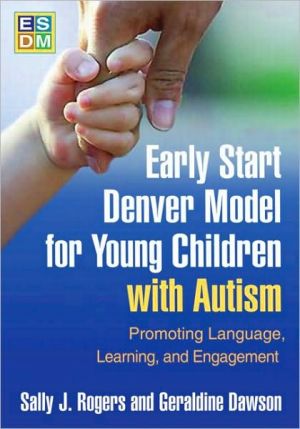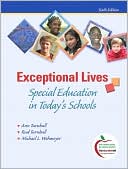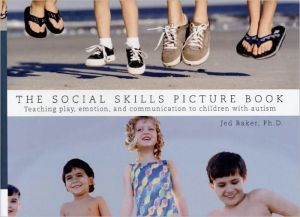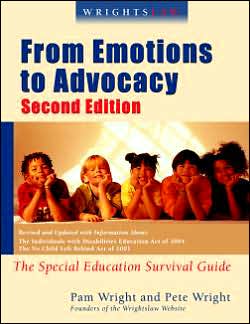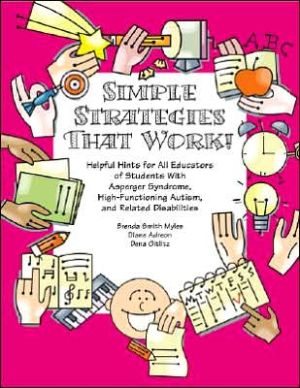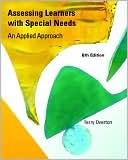Early Start Denver Model for Young Children with Autism
From Leading Authorities, this State-of-the-Art Manual Presents the Early Start Denver Model (ESDM), the first comprehensive, empirically tested intervention specifically designed for toddlers and preschoolers with autism. Supported by the principles of developmental psychology and applied behavior analysis, ESDM's intensive teaching interventions are delivered within play-based, relationship-focused routines. The manual provides structured, hands-on strategies for working with very young...
Search in google:
From leading authorities, this state-of-the-art manual presents the Early Start Denver Model (ESDM), the first comprehensive, empirically tested intervention specifically designed for toddlers and preschoolers with autism. Supported by the principles of developmental psychology and applied behavior analysis, ESDM’s intensive teaching interventions are delivered within play-based, relationship-focused routines. The manual provides structured, hands-on strategies for working with very young children in individual and group settings to promote development in such key domains as imitation; communication; social, cognitive, and motor skills; adaptive behavior; and play. Implementing individualized treatment plans for each child requires the use of an assessment tool, the Early Start Denver Model Curriculum Checklist for Young Children with Autism. A nonreproducible checklist is included in the manual for reference, along with instructions for use; 8½" x 11" checklists are sold separately in sets of 15 ready-to-use booklets.
Chapter 1 Current Understanding of Infant Learning and Autism 1How Infants Learn 2How Brain Development Supports the Acquisition of Social-Communicative Skills 4How Autism Likely Affects Brain Development and Learning 8Brain Changes in Early Childhood and Beyond 12The Role of Early Intervention in Shaping Early Brain Development and Outcome in Autism 13Chapter 2 An Overview of the Early Start Denver Model 14Foundations of the ESDM 14The ESDM Curriculum 17ESDM Teaching Procedures 19Evidence of Effectiveness 29Similarities and Differences between the ESDM and Other Intervention Models for Toddlers with ASD 33Conclusion 34Chapter 3 Using the Early Start Denver Model 35Delivery Settings 35Delivery to Whom? 36Delivery by Whom? 36ESDM Procedures 37Using the Generalist Model to Deliver Intervention 39The Interdisciplinary Treatment Team 40Partnering with Families 50Transitioning Out of the ESDM Intervention 55Conclusion 57Chapter 4 Developing Short-Term Learning Objectives 58Assessment Using the ESDM Curriculum Checklist 58Constructing the Learning Objectives 68Balancing objectives across Domains 68How Many Objectives? 68Selecting Skill Content 69Elements of the Objective 70Writing Functional Objectives 75Isaac's 12-Week Learning Objectives 76Conclusion 79Chapter 5 Formulating Daily Teaching Targets and Tracking Progress 80Mapping Out Learning Steps for Each Objective 80Tracking Progress 87Summary 94Appendix 5.1. Learning Objectives and Learning Steps for Isaac 95Chapter 6 Developing Plans and Frames for Teaching 101Becoming a Play Partner 102Joint Activity Routines: Framesfor Teaching 108Managing Unwanted Behaviors 120Organizing and Planning the Session 123When Children Aren't Progressing: A Decision Tree 130Conclusion 134Chapter 7 Developing Imitation and Play 136Teaching Imitation 136Teaching Play Skills 146Conclusion 153Chapter 8 Developing Nonverbal Communication 154Coordinating Attention Underlies Communication 155Developing Use and Understanding of Natural Gestures 156Teaching Conventional Gesture Use 160Conclusion 166Chapter 9 Developing Verbal Communication 168Stimulating Development of Speech Production 169Receptive Language 179Conclusion 182Chapter 10 Using the Early Start Denver Model in Group Settings 184Considering Characteristics of Autism in Classroom Organization 185Physical Organization 186Planning the Daily Schedule and Routines 189Choreography of the Classroom 192Staff Planning and Communication 192Small- and Large- Group Instruction 194Classroom Behavior Management 197Transitions and Individual Schedule Systems 198Curriculum for Peer Relations and Self-Care 202Kindergarten Transition 206Conclusion 207Appendix A Early Start Denver Model Curriculum Checklist and Item Descriptions 209Introduction 209Administration 210Scoring 211Translating Items into Teaching Objectives 211Materials Needed 212Early Start Denver Model Curriculum Checklist for Young Children with Autism 213Early Start Denver Model Curriculum Checklist: Item Descriptions 230Appendix B Early Start Denver Model Teaching Fidelity Rating System: Administration and Coding 259Procedure for Coding Fidelity of Treatment Implementation 259Early Start Denver Model 261Early Start Denver Model Fidelity CodingSheet 271References 273Index 287
\ From the Publisher"This book marks a very significant milestone in the development of appropriate interventions for young children with autism spectrum disorders. The integration of goals and teaching strategies from developmental, behavioral, and context-oriented approaches is unique. The chapters on theory will press even experienced interventionists to think about what they are attempting and why, and the detailed descriptions of activities show exactly how theory meets practice. With multisite research underway to test the encouraging results of early studies, this manual will enable interventionists to think more broadly; choose concrete, measurable, and useful goals for each child; and collaborate across disciplines within a comprehensive intervention framework."--Catherine Lord, PhD, ABPP, Director, University of Michigan Autism and Communication Disorders Center \ "A huge achievement. This book will be indispensable to clinicians, educators, and others who care for young children with autism. Two distinguished scientist-practitioners have teamed up to present an innovative, evidence-based, comprehensive intervention that integrates developmental principles with applied behavior-analytic teaching approaches. Written in a clear and engaging style with many helpful case examples, the book takes readers step by step through all aspects of the intervention--its conceptual framework, initial evaluation of the child with autism, collaboration with the child's family, curriculum design, teaching methods, and systems for monitoring progress."--Tristram Smith, PhD, Division of Neurodevelopmental and Behavioral Pediatrics, University of Rochester Medical Center \ "Rogers and Dawson have met an important need for early intervention service providers with this stunningly comprehensive manual. The great strength of the manual is its blend of scientific and practical knowledge that focuses on producing important developmental outcomes for children. It presents an assessment process and instrument (the Early Start Denver Model Curriculum Checklist) that pinpoint important developmental goals, as well as detailed information about practices and fidelity that will be of great benefit to service providers who want to implement the model. The Early Start Denver Model for Young Children with Autism is one of the best examples of translating science into practice; it will serve as the standard against which future treatment manuals in the field are judged."--Samuel L. Odom, PhD, Director, Frank Porter Graham Child Development Institute, University of North Carolina at Chapel Hill\ \ \ \ \ \ Journal of Autism and Developmental Disorders"Among the crowd of treatments, interventions, and purported cures that proliferate around autism spectrum disorders, the Denver Model has long stood as a beacon of empirical rigor and developmental sensitivity....Sally Rogers and Geri Dawson, two of the most experienced and accomplished psychologists working in autism today, have laid out the details of a modification of their program designed for toddlers and very young children....By conducting a carefully designed study before publishing their program, they have established an empirical basis for it that provides a high level of added value. Parents and educators who use the program have not just its authors' endorsement, but a scientific basis for validity. The book is written in an engaging and accessible way. One of its best features is its excellent first chapter, which explains in lay terms what is known about brain development and ASD....This book adds greatly to the growing literature on evidence-based naturalistic behavioral treatments for children with ASD. Its attention to the needs of children under three, now frequently diagnosed with the syndrome, as well as its comprehensive scope and reader-friendly style should guarantee it a well-deserved place on the bookshelves of all who are engaged in the difficult task of optimizing the developmental trajectory of young children with this syndrome."--Journal of Autism and Developmental Disorders\ \ \ Child and Adolescent Mental Health Journal"Sets an extremely high standard against which future manuals will be judged. Even for those not intending to replicate the programme in its entirety, the strategies for enhancing play, imitation and communication, and for improving parent/child interaction are potentially extremely helpful for parents and teachers, and for professionals advising them."--Child and Adolescent Mental Health Journal\ \
